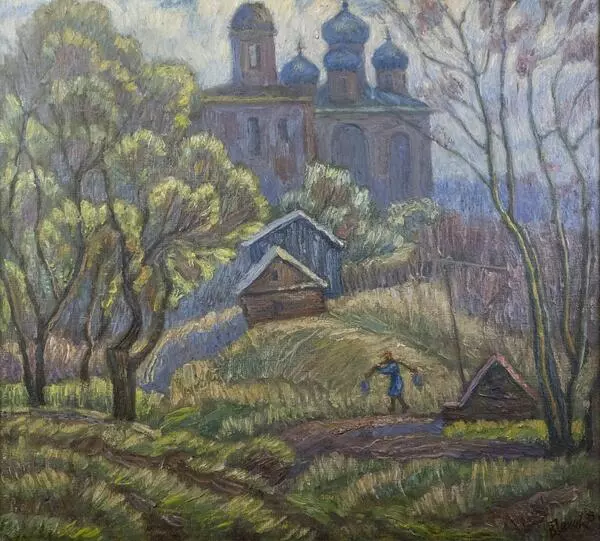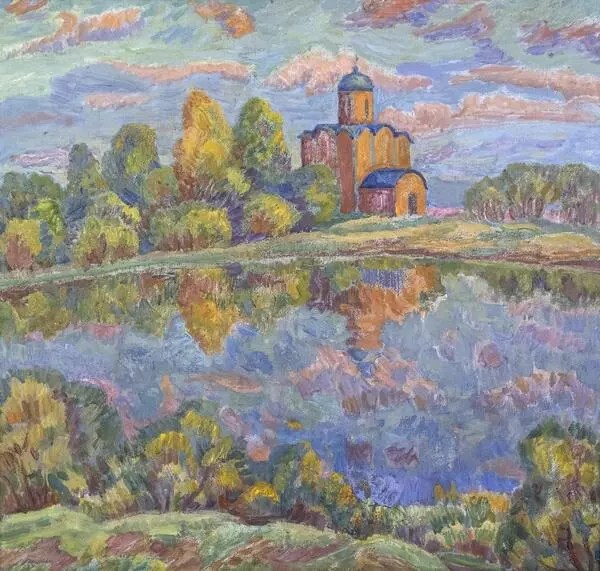The St. Blaise, or Vlasevskaya Church stands in the north of the People’s End of Veliky Novgorod, at the very end of the former Volosovaya Street.
The connection between the names of this street and the church is quite interesting.
It is believed that Saint Blaise is a patron of cattle; in this, researchers see a continuity between the Christian cult and the ancient pagan one. According to Valentin Lavrentievich Yanin, who based his opinion on the general requirements of propriety during the Christianization period, which mandated building a Christian church on the site of a former pagan temple, the first St. Blaise Church stood where a temple of the “cattle god” Veles (Volos) had been. Veles was revered by the Slavs. Boris Alexandrovich Rybakov also associated the name of the street with Volos. However, Valery Leonidovich Vasiliev claimed that there was no archaeological evidence of a Veles’s temple.
Mark Khaimovich Aleshkovsky pointed out that the church appeared later than the street and stood at the end, rather than beginning. According to the scientist, the name of the St. Blaise Church — Vlasyevskaya — is derived from the common anthroponym “Volos”.
For the first time, the wooden church of the Holy Martyr Blaise of Sebaste is mentioned in clerical documents of 1111. In the chronicles of 1184, it is confirmed that “in the same summer” the wooden church of St. Blaise was built.
The second, also wooden, church was erected there in 1379; the stone one — only in 1407.
Its status changed: in 16th-century sources, it is mentioned as a cathedral, with a chapel of Joachim and Anne in the matroneum (gallery), later — as a government-sponsored church, without parishioners and receiving a state allowance.
Up to the 19th century, the church was periodically rebuilt and its architectural features were improved.
It was severely damaged during the years of the German occupation; in the late 1940s — early 1950s, the bell tower and the porch were dismantled. The church was to be demolished.
Moscow and Leningrad scientists, who convinced the Novgorod authorities of the value of this architectural monument, did not allow it to happen.
In 1954–1959, Dmitry Mikhailovich Fyodorov developed a project to restore the church to its 15th-century state. To recreate the original appearance of the building — the dome, vaults, portals with nested arches and windows with pointed arches — the architect relied on some seemingly insignificant features, like the elegant ornament bordering the drum.
The remnants of the frescos depicting the Holy Martyr Blaise can still be seen in the niche above the northern portal.
Today the church is closed.
The connection between the names of this street and the church is quite interesting.
It is believed that Saint Blaise is a patron of cattle; in this, researchers see a continuity between the Christian cult and the ancient pagan one. According to Valentin Lavrentievich Yanin, who based his opinion on the general requirements of propriety during the Christianization period, which mandated building a Christian church on the site of a former pagan temple, the first St. Blaise Church stood where a temple of the “cattle god” Veles (Volos) had been. Veles was revered by the Slavs. Boris Alexandrovich Rybakov also associated the name of the street with Volos. However, Valery Leonidovich Vasiliev claimed that there was no archaeological evidence of a Veles’s temple.
Mark Khaimovich Aleshkovsky pointed out that the church appeared later than the street and stood at the end, rather than beginning. According to the scientist, the name of the St. Blaise Church — Vlasyevskaya — is derived from the common anthroponym “Volos”.
For the first time, the wooden church of the Holy Martyr Blaise of Sebaste is mentioned in clerical documents of 1111. In the chronicles of 1184, it is confirmed that “in the same summer” the wooden church of St. Blaise was built.
The second, also wooden, church was erected there in 1379; the stone one — only in 1407.
Its status changed: in 16th-century sources, it is mentioned as a cathedral, with a chapel of Joachim and Anne in the matroneum (gallery), later — as a government-sponsored church, without parishioners and receiving a state allowance.
Up to the 19th century, the church was periodically rebuilt and its architectural features were improved.
It was severely damaged during the years of the German occupation; in the late 1940s — early 1950s, the bell tower and the porch were dismantled. The church was to be demolished.
Moscow and Leningrad scientists, who convinced the Novgorod authorities of the value of this architectural monument, did not allow it to happen.
In 1954–1959, Dmitry Mikhailovich Fyodorov developed a project to restore the church to its 15th-century state. To recreate the original appearance of the building — the dome, vaults, portals with nested arches and windows with pointed arches — the architect relied on some seemingly insignificant features, like the elegant ornament bordering the drum.
The remnants of the frescos depicting the Holy Martyr Blaise can still be seen in the niche above the northern portal.
Today the church is closed.





